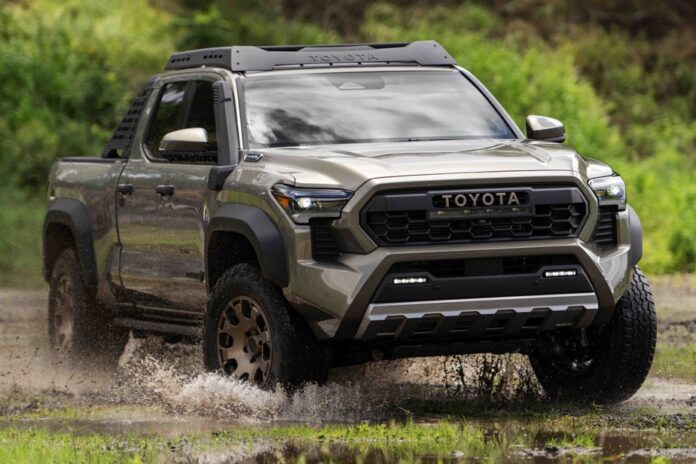(Kona, Hawaii) The top of the class always ends up annoying the others a little. By dint of seeing it there, at the very top, the competition, one suspects it, slyly dreams of a bad patch, of the moment when it will stumble. Yes, the Tacoma makes people jealous. Its world premiere unveiling last Friday is already arousing hope and apprehension among its rivals.
Will the Tacoma once again get the better of all the new stuff being thrown at it? At Toyota, we are aware that they are numerous this year and that they will appear almost simultaneously on the market. Chevrolet (Colorado), GMC (Canyon) and Ford (Ranger), to name a few, all aspire to unbolt the Tacoma from its pedestal. “We hope to keep our leading position,” Toyota management said, taking great care not to give the impression that it was steeped in complacency.
The Tacoma has been the best-selling midsize pickup in Canada—and the United States, too—for the past 20 years. Since its launch in 1995, its good fortune has been in a subtle, but invariable equation, which its first three generations have successfully declined: to be robust, reliable and versatile. Other comparable models have the same qualities, but few offer all of these at once.
The redesign of the Tacoma, the fourth in its history, adopts the architecture of the current Tundra and Sequoia. Known as the TNGA-F, this ladder frame is more rigid than the one used previously. It is also dressed, in its upper part, with aluminum panels to reduce the weight and the center of gravity. Its wider tracks will benefit its stability at cruising speed. An architecture that the future 4Runner will take over very soon.
Both exterior and interior dimensions have remained essentially the same as those of the previous generation, with the exception of headroom. At the commercial launch of this Mexico-assembled pickup truck, Toyota Canada will offer only one cab choice (Double Cab), but two bed lengths (5′ or 6′). A two-seater model (Xtracab) will join the range at a later date.
None of the mechanics that once moved the Tacoma have been retained. They’ve all been pushed out in favor of a supercharged 2.4L four-cylinder engine with 278 hp and 317 lb-ft of torque. To this will be added, from the first quarter of 2024, a strong hybrid version of 326 hp and 465 lb-ft of torque, but still unable to tow a larger load. Indeed, Toyota limits it to 6,000 lbs, 500 less than the all-gas version.
In its “all gasoline” configuration, this engine agrees to marry a manual transmission – a rarity these days, but sought after by 10% of our customers, specifies Romaric Lartilleux, spokesperson for Toyota Canada. The hybrid version, for its part, will have to rely on an eight-speed automatic transmission, which incorporates in its housing an electric motor with a power equivalent to 48 hp. The latter is powered by a 1.87 kWh battery. Toyota does not yet communicate any data on the consumption of these two engines.
To make the attractions of the Tacoma even more palpable, the equipment has been treated. As standard, all models come with four disc brakes (there used to be drums at the rear) and electric power steering. Inside, the Tacoma now has a steering column adjustable on two axes (inclination and depth) and it will now be possible to raise the cushion of the front seats to obtain a more pleasant driving position. On that note, the Tacoma TRD Pro exclusively adopts competition-inspired bucket seats to provide support and comfort in off-road use.
The Japanese manufacturer does not reveal anything about the prices of its newcomer, but suggests that the improvements made will have a cost. In Canada, all Tacomas will come standard with four-wheel drive mode, multi-link rear suspension and a slew of driver aids, including blind-spot sensors.















